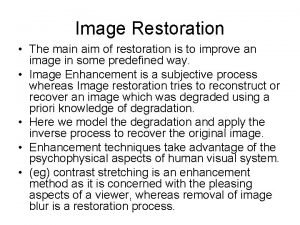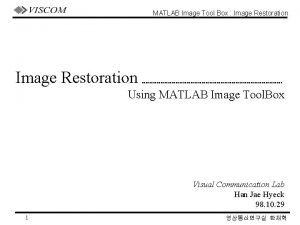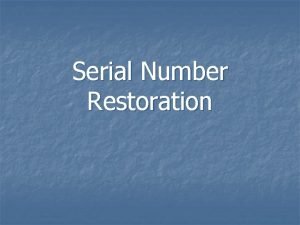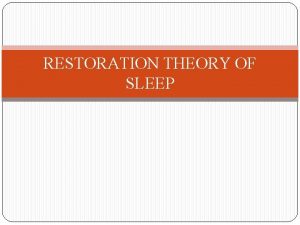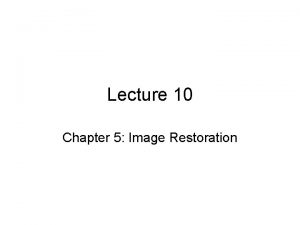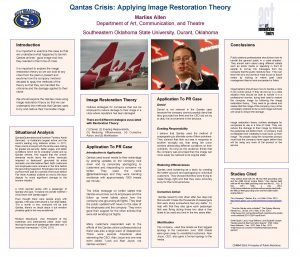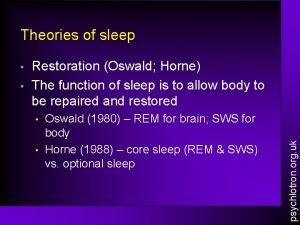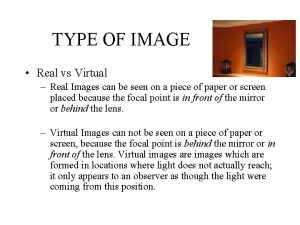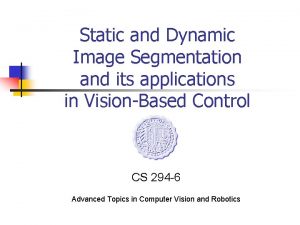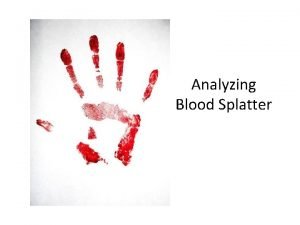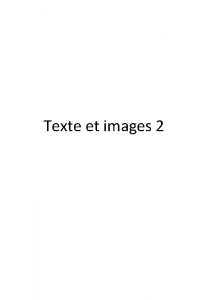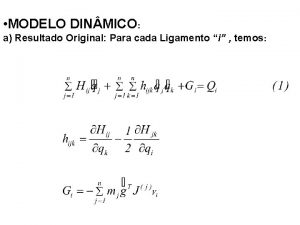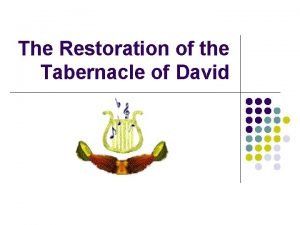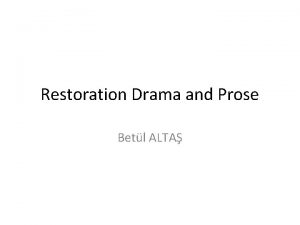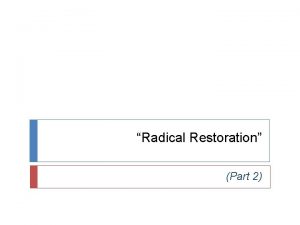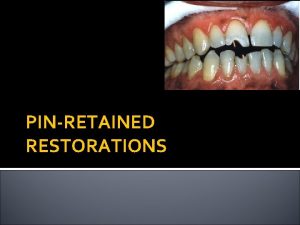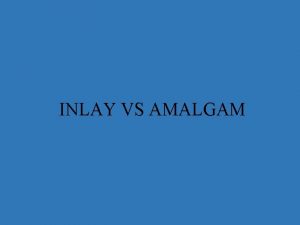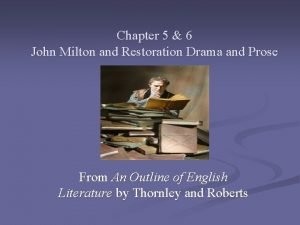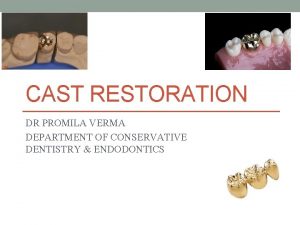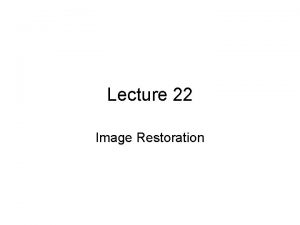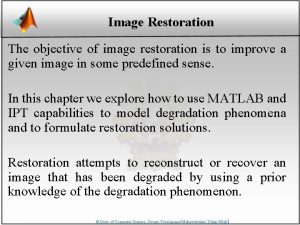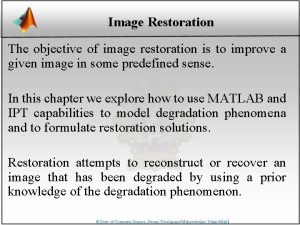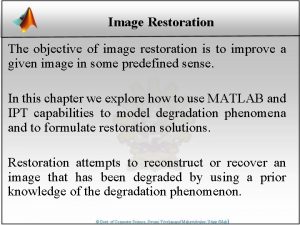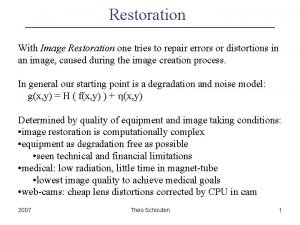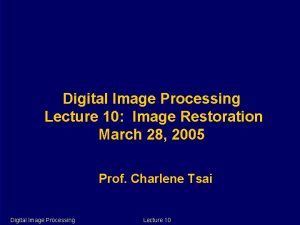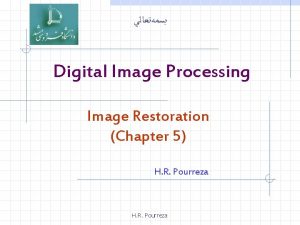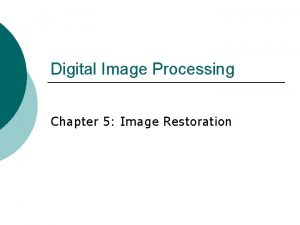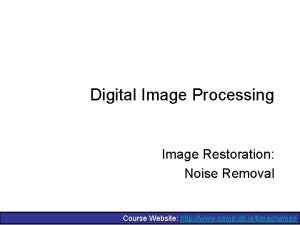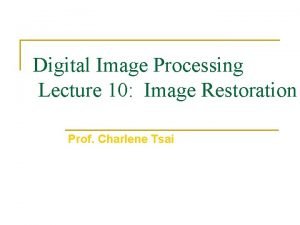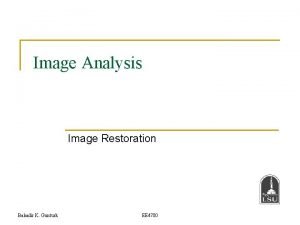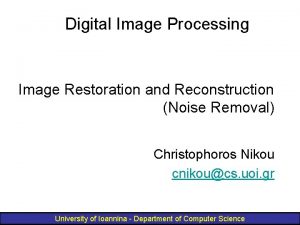CH 5 Image Restoration 5 1 A model



















































- Slides: 51

CH 5. Image Restoration 5. 1 A model of the image degradation/ restoration process 5. 2 Noise models 5. 3 Restoration in the presence of noise only-spatial filtering 5. 4 Noise reduction by freq. domain filtering 5. 5 Linear, position-invariant degradation 5. 6 Estimating the degradation function 5. 7 Inverse filtering, Wiener filtering, Constraint least squares filtering, Geometric mean filter 1

Chapter 5 Image Restoration • Image Restoration is distinguished from Image Enhancement (CH. 3 -4) - IE: heuristic, subjective process, e. g. contrast stretching - IR: objective process, e. g. removing blur • The degradation modeling and inverse process to get back to the original image 2

5. 1 A Model of the Image Degradation / Restoration Process • f(x, y): input image • H is the degradation operator • η: noise 3

5. 1 A Model of the Image Degradation / Restoration Process • If degradation H is a linear, position-invariant process, the degraded image in the spatial domain is • Therefore, in the frequency domain it is 4

5. 1 A Model of the Image Degradation / Restoration Process Noisy Channel Noise Due to Channel (known properties) Remove Noise Inverse Process 5

5. 2 Noise Models l The major problem of noise in image comes up during acquisition and/or transmission l Probability Density Function(PDF) tools are useful for modeling a broad range of noise corruption situation l Spatial noise descriptor is the statistical behavior of the intensity values in the noise component 6

5. 2 Noise Models 7

5. 2 Noise Models 8

5. 2 Noise Models 9

5. 2 Noise Models 10

A. Gaussian Noise l Gaussian (normal) noise is very attractive from a mathematical point of view since its DFT is another Gaussian process. l PDF of Gaussian r. v is 11

B. Rayleigh Noise l. This noise is specified as l. The mean and variance are given by l. The Rayleigh density is useful for approximating skewed histograms 12

C. Erlang Noise l Erlang noise specified as l Here a>0 and b is a positive integer. The mean and variance are given by 13

C. Erlang Noise l When the denominator is the gamma function, the pdf describes the gamma distribution 14

D. Exponential Noise l Exponential noise is specified as l Here a>0. The mean and variance are given by 15

D. Exponential Noise Exponential pdf is a special case of Erlang pdf with b=1. l 16

E. Uniform Noise l. Uniform noise is specified as l. Here a>0. The mean and variance are given by 17

F. Impulse (salt-and-pepper) Noise l. Impulse noise (bipolar) is specified as l. If b>a, intensity b will appear as light dot on the image and a appears as a dark dot. If either Pa or Pb is zero, the noise is called unipolar. 18

F. Impulse (salt-and-pepper) Noise l. If b>a, intensity b will appear as light dot on the image and a appears as a dark dot. If either Pa or Pb is zero, the noise is called unipolar. Frequently, a and b are saturated values, resulting in positive impulses being white and negative impulsees being black. 19

5. 2 Noise Models l It is possible to estimate the parameters of the PDF from small patch of background intensity, when only images are available l The shape of histogram identifies the closest PDF match 20

5. 2 Noise Models Estimation of noise parameters 21

5. 2 Noise Models Periodic noise 22

23

5. 3 Restoration in the Presence of Noise only Spatial Filtering l. When the only degradation in the image is noise: l. The noise terms are unknown, so subtracting them from g(x, y) or G(u, v) is not realistic option l. Spatial filtering should be more preferable when only additive random noise is present 24

5. 3. 1 Mean Filters Arithmetic mean filter: • Let Sxy represent the set of coordinates in a rectangular neighborhood of size m x n, centered at the point (x, y). • The arithmetic mean filter computed the average value of the corrupted image g(x, y) in the area defined by Sxy. 25

5. 3. 1 Mean Filters • The output is an arithmetic mean: 26

5. 3. 1 Mean Filters Geometric mean filter: • Geometric mean filter achieves smoothing comparable to the arithmetic mean filter but it preserves more details 27

5. 3. 1 Mean Filters Harmonic mean filter: • Harmonic mean filter works well for salt noise and other types of noise (such as Gaussian) but fails for pepper noise 28

5. 3. 1 Mean Filters Contraharmonic mean filter: • Here Q is the order of the filter. This filter is well suited for reducing the effect of salt-pepper noise. • For positive values of Q, it eliminates pepper noise; for negative values of Q, it eliminates salt noise. 29

5. 3. 1 Mean Filters • This filter cannot reduce both simultaneously. • Notice the contraharmonic filter reduces to the arithmetic mean filter when Q=0 and to the harmonic mean filter if Q =-1 30

5. 3. 1 Mean Filters 31

5. 3. 1 Mean Filters 32

5. 3. 1 Mean Filters 33

Restoration filter performance? 34

Restoration filter performance? l Objective Image Quality - PSNR (Peak Signal-to-Noise Ratio), MSE, SSIM (structural similarity index) , etc. l Subjective Image Quality - MOS, NMOS, etc. ACR (Absolute Category Rating): each image sequence is rated individually on the ACR scale. The labels on the scale are "bad", "poor", "fair", "good", and "excellent", and they are translated to the values 1, 2, 3, 4 and 5 when calculating the MOS (Mean Opinion Score). 35

Restoration filter performance? • Peak Signal-to-Noise Ratio, (PSNR): It is the ratio between the max power of a signal and the power of corrupting noise • PSNR is usually expressed in terms of the logarithmic decibel scale. PSNR is most commonly used to measure the quality of reconstruction • PSNR is most easily defined via the mean squared error (MSE). Given an original image I(i, j) and its noisy approximation K(i, j), MSE is defined as: 36

5. 3. 2. Order-statistics Filters They are filters whose response is based on ordering (ranking) pixels a) Median filter: replaces the pixel value by the median of the intensity levels in the neighborhood of that pixel 37

5. 3. 2. Order-statistics Filters • Median filters provide excellent results for certain types of noise with considerably less blurring than linear smoothing filters of the same size • These filters are very effective against both bipolar and unipolar noise contaminations 38

5. 3. 2. Order-statistics Filters 39

5. 3. 2. Order-statistics Filters b) Max and Min Filter: the filter is useful for finding the brightest points in an image; therefore, its effective against pepper noise • The filter is useful for finding the darkest points in an image; therefore, its effective against salt noise 40

5. 3. 2. Order-statistics Filters 41

5. 3. 2. Order-statistics Filters c) Midpoint Filter: computes the midpoint between the maximum and minimum values of intensities: • This filter is a combination of order statistics and averaging and works best for Gaussian and uniform noise contaminations 42

5. 3. 2. Order-statistics Filters d) Alpha-trimmed Mean Filter: if we delete d/2 highest intensity values and d/2 lowest intensity values, denote the rest as g(x, y); a filter that averages what is left is alphatrimmed mean filter: 43

5. 3. 2. Order-statistics Filters • d can range from 0 to mn-1. When d=0, this filter reduces to the arithmetic mean filter, when d=mn-1, this filter reduces to a median filter. • For other values of d, the filter is useful against contaminations with noise of multiple types, such as a combination of saltand-pepper and Gaussian noise 44

5. 3. 2. Order-statistics Filters 45

5. 3. 3 Adaptive Filters • The behavior of adaptive filters changes based on statistical characteristics (var. mean) of the image inside the filter region Sxy, m x n local window region - The mean gives a measure for average intensity in the region - The variance characterizes contrast in that region, they both are reasonable parameters to base an adaptive filter. 46

a) Adaptive local noise reduction filter: 47

5. 3. 3 Adaptive Filters 48

5. 3. 3 Adaptive Filters b) Adaptive median filter: can handle impulse noise with larger probabilities than traditional median filter. It operates on a rectangular region whose size is changing • Adaptive median filter has 3 goals to remove impulse noise, to provide smoothing of other noise, and to reduce distortion 49

5. 3. 3 Adaptive Filters 50

Summary 1. A Model of the Image Degradation/ Restoration Process 2. Noise Models: • Gaussian, Rayleigh, Erlang, Exponential, Uniform, Impulse 3. Restoration in the Presence of Noise Only-Spatial Filtering: • Mean (Arithmethic, Geometric, Harmonic, Contraharmonic mean filter) • Order-statistic (Median, Max. /Min. , Midpoint, Alphatrimmed mean filter) 4. Restoration filter performance – PSNR, MSE, MOS , etc.
 Optimum notch filter in digital image processing
Optimum notch filter in digital image processing Image restoration is to improve the dash of the image
Image restoration is to improve the dash of the image Noise
Noise Image sharpening and restoration
Image sharpening and restoration Image restoration matlab
Image restoration matlab Number restoration
Number restoration Image restoration theory
Image restoration theory Image restoration theory
Image restoration theory Image restoration adalah
Image restoration adalah Image restoration theory
Image restoration theory Compression in digital image processing
Compression in digital image processing Objective fidelity criteria
Objective fidelity criteria Fundamental steps in digital image processing
Fundamental steps in digital image processing Oswald's restoration theory of sleep
Oswald's restoration theory of sleep What are real and virtual image
What are real and virtual image Virtual and real images
Virtual and real images Translate
Translate Key stages in digital image processing
Key stages in digital image processing Analog image and digital image
Analog image and digital image Motion segmentation
Motion segmentation Geometric transformation in digital image processing
Geometric transformation in digital image processing Search for an image using an image
Search for an image using an image Ce n'est pas une image juste c'est juste une image
Ce n'est pas une image juste c'est juste une image Difference between logical file and physical file
Difference between logical file and physical file Perturbação
Perturbação Image transforms in digital image processing
Image transforms in digital image processing Image geometry in digital image processing
Image geometry in digital image processing E
E Oren freifeld
Oren freifeld Post-partum restoration technology
Post-partum restoration technology Restoring the tabernacle of david
Restoring the tabernacle of david Meiji restoration
Meiji restoration 5 element of national identity
5 element of national identity Sheridan comedy of manners
Sheridan comedy of manners How to restore serial numbers by acid etching
How to restore serial numbers by acid etching San joaquin river restoration program
San joaquin river restoration program Restoration drama and prose
Restoration drama and prose Restoration colonies
Restoration colonies Radical restoration
Radical restoration Preventive adhesive restoration
Preventive adhesive restoration Pin retained restoration
Pin retained restoration Disaster restoration buchanan county
Disaster restoration buchanan county Nyc doe lodi
Nyc doe lodi Gulfport restoration company
Gulfport restoration company Meji era japan
Meji era japan Meiji restoration
Meiji restoration Circumferential tie in inlay
Circumferential tie in inlay Tooth preparation for composite restoration
Tooth preparation for composite restoration Chapter 56 conservation biology and restoration ecology
Chapter 56 conservation biology and restoration ecology Phosphorus cycle pearson education
Phosphorus cycle pearson education Restoration drama and prose
Restoration drama and prose Flare in cavity preparation
Flare in cavity preparation

